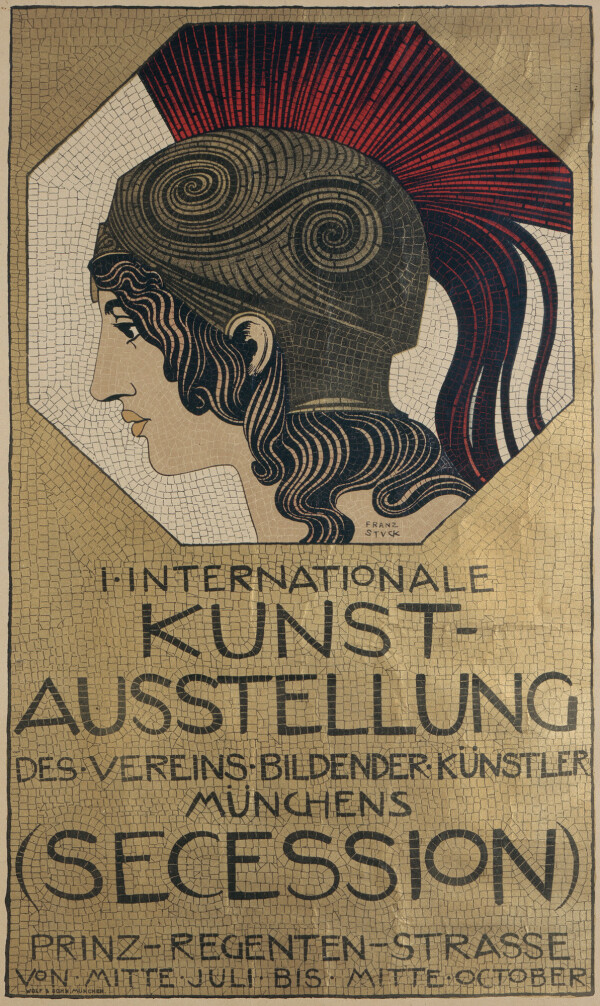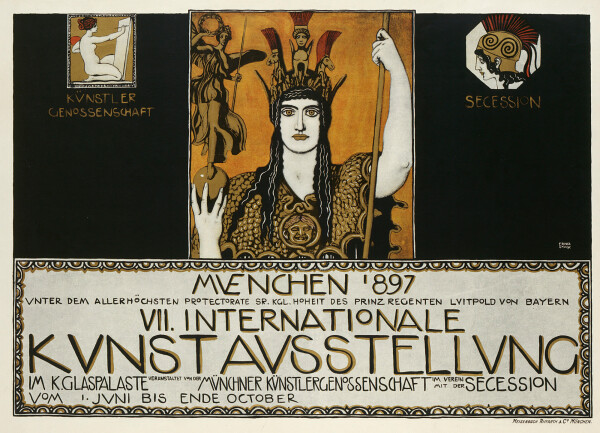The Munich Secession

Franz von Stuck: Poster of the I International Art Exhibition of Munich Association, 1893, Munich City Museum, Collection of Advertising Art
© Münchner Stadtmuseum, Sammlung Reklamekunst

Franz von Stuck: Poster of the VII. International Art Exhibition in the Royal Glass Palace in Munich, 1897, Munich City Museum, Advertising Art Collection
© Münchner Stadtmuseum, Sammlung Reklamekunst
The Munich Secession stood for a departure from the conservative understanding of art rooted in Historicism. With its striving for freedom, it heralded a new era both stylistically and on the art market, and was also to pave the way for the Vienna and Berlin Secessions.
On 4 April 1892, there was a break within the long-established Munich Cooperative of Artists. 96 members left the association to found the Verein bildender Künstler Münchens e.V. [Association of Visual Artists in Munich], which would soon be referred to as Secession. This made the Munich Secession the first association of its kind using this name. Among its founding members were important fin-de-siècle artists, including Fritz von Uhde, Lovis Corinth, Hugo von Habermann, Max Liebermann, and Franz von Stuck. The latter was a member of the association’s committee from 1892 to 1914 and played a major role when it came to organizing exhibitions.
The art policy under Prince Regent Luitpold of Bavaria favored traditional history painting preferably featuring nationalist subject matter. The state was rather critical of modern international art movements such as Impressionism, Symbolism, and Expressionism. The goal of the new association of artists was therefore to initiate a counter-movement to the prevailing conservative art scene. It promoted the banding together of like-minded artists interested in a modern approach to art beyond academic norms. By working together, the Munich Secessionists hoped to herald a turning point and thus to also achieve a better economic position for their members in the exhibition business.
Franz von Stuck’s Pallas Athena (1898, Museum Georg Schäfer, Schweinfurt), regarded as the patron goddess of the arts and sciences, would be the association’s symbol of many years. It already appeared on the first exhibition poster and would henceforth serve as the Munich Secession’s figurehead and trademark. The Vienna Secession would subsequently also choose the motif of Pallas Athena for its first exhibition, based on a design by Gustav Klimt.
After initial difficulties in finding a suitable exhibition venue, the “I. Internationale Kunst-Ausstellung” [“1st International Art Exhibition”] opened on 16 July 1893 in a specially constructed building on Prinzregentenstraße. 297 artists exhibited more than 876 works of art. With over 4,000 visitors on the first Sunday of the exhibition, the Secessionists received a lively response.
The opening up to foreign countries brought artists from all over Europe and their works to Munich, thus strengthening the city’s position as an international art metropolis. Among them were renowned exponents of Impressionism and Symbolism, such as Gustave Courbet, Fernand Khnopff, Jan Toroop, Giovanni Segantini, Auguste Rodin, and Walter Crane.
Munich as a Role Model for the Secessionist Movement
Artists throughout Europe soon followed the example of the Munich Secession. In Germany, Darmstadt, and Dresden, the next Secessions were to split off. As early as 1894, the artist Carl Moll, who at the time was one of the progressive forces at the Vienna Künstlerhaus along with Klimt, Bernatzik, Engelhart, and Krämer, invited the Munich Secession to Vienna to join a guest exhibition together with the Düsseldorf Secession. Less than three years later, in 1897, the Vienna Secession was founded on the initiative of the aforementioned artists. The Berlin Secession was founded in 1899. A Secession was also founded outside the German-speaking world in Rome, but it did not last long. Similar associations formed in the United States and Japan.
As all of the Secessionist movements pursued a similar goal, namely to revolutionize and modernize the art world, the Union of German Artists was founded for the German-speaking countries in 1903 to function as an umbrella organization for the numerous Secessions. In 1904, its first exhibition took place on the premises of the Munich Secession. As a member of the Union of German Artists, Klimt took part in exhibitions in Munich, Berlin, Leipzig, and Mannheim.
In 1905, the Munich Secession decided to compile a contemporary art collection – today’s Secession Gallery – in order to establish a permanent display of contemporary art curated by artists. A similar endeavor was under way in Vienna, with the initiation of the Modern Gallery [now Belvedere, Vienna].
When the Nazi regime rose to power and the cultural scene was “purged” of degenerate art, the Munich Secession was dissolved in 1938. After World War II, the association, which still exists today, resumed its activities.
Literature and sources
- Münchener Secession. muenchenersecession.de/secession/ (11/08/2022).
- Münchner Feuilleton. muenchner-feuilleton.de/2017/05/06/muenchner-secession-die-abtruennigen/ (04/27/2020).
- N. N.: Die Geschichte der Münchener Secession. Eine Chronologie, in: Jochen Meister (Hg.): Münchner Secession. Geschichte und Gegenwart, Münch 2007, S. 8-27.
- Michael Buhrs: Die Münchner Secession 1892-1914, Wolfratshausen 2008.
- Cornelia Cabuk: Carl Moll. Monografie und Werkverzeichnis, in: Stella Rollig (Hg.): Belvedere Werkverzeichnisse, Band 11, Vienna 2020.
- Adolf Hölzel: Über Formen und Massenvertheilung im Bilde, in: Vereinigung bildender KünstlerInnen Wiener Secession (Hg.): Ver Sacrum. Mitteilungen der Vereinigung bildender Künstler Österreichs, 4. Jg., Heft 15 (1901), S. 246-254.

